The Best Snowblowers for Digging Yourself Out This Winter
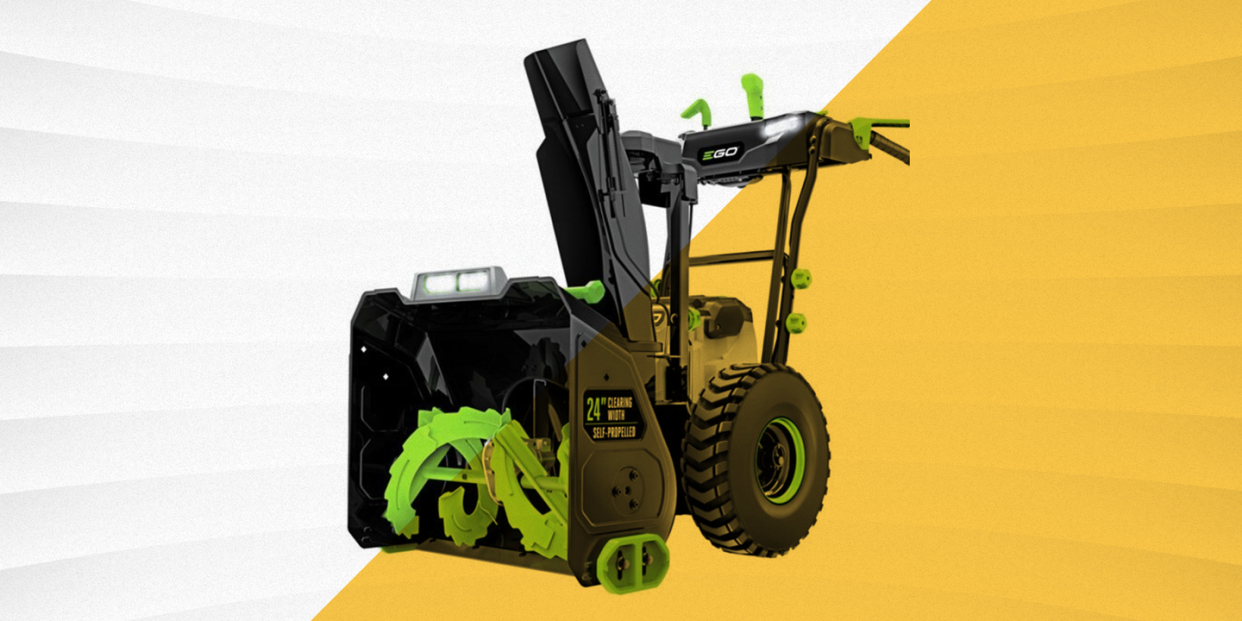
"Hearst Magazines and Yahoo may earn commission or revenue on some items through these links."
Waking to a fresh blanket of snow brings back memories of childhood, with school called for the day and the only thing on your agenda is sledding with friends. But we’re not kids anymore, and the realization that we have to unbury the car and head to work quickly clears the nostalgic fog from our minds. If you’ve finally gotten tired of shoveling, need to replace an aging snowblower, or just want something bigger and better, we have snow removal options for you. The snowblowers here run from petite to some of the largest available and include both battery- and gas-powered models. If you expect precip that needs clearing this season, you’ll find a snowblower on this list that’s ideal for you.
The Best Snowblowers
What You Need to Know About Snowblowers
Gas- or Battery-Powered
The big limiting factor for cordless snowblowers is how long they’ll run. If the battery dies, there are two options: Put a second battery in, if you have one, or put it on the charger and wait. Battery options do have their advantages, though. They produce no fumes, emit very little noise, are simple to operate, and can be stored anywhere in your home. Typical cordless units can handle snow up to 13-inches deep and run up to 30 to 45 minutes. Gas snowblowers can easily handle snow 20-inches deep or more and, with enough gas, run for hours on end. And if you run out of gas, just add fuel and keep going. The choice comes down to how much snow you typically get, and how much space you have to clear.
One-Stage or Two-Stage
Much like the choice between gas or battery power, choosing one or two stages has a lot to do with snow volume and the area to be cleared. One-stage blowers are so called because they have one curved paddle that collects the snow and ejects it. This limits how far the snow can be thrown, as well as the amount that can pass through the machine. One-stage units are simple to operate, light, easy to maneuver, and less expensive than two-stage machines. Two-stage units have a horizontal auger that collects snow and pushes it to a separate, rotating impeller that ejects it. Two-stage machines can throw snow 30 to 60 feet, which makes it easier to clear large areas without piling snow that you’ll just have to move again.
Drive Systems
The main purpose of a drive system is to adjust and convert engine RPMs to an appropriate speed to drive the machine forward in various conditions. There are two basic types of transmissions: friction disc and hydrostatic.
Friction-disc transmissions are simple, mechanical devices that employ a rubber-edged wheel that presses on the face of a large pulley. By repositioning the wheel on the face of the pulley, the machine will speed up or slow down—closer to the center for slower, close to the outside edge for faster. Snowblowers with friction discs will often have six forward speeds and two reverse, controlled by a lever on the dashboard. And these machines typically have a live axle, which means both wheels are attached to a solid axle and will always spin at the same rate.
Hydrostatic transmissions pump hydraulic fluid through hydraulic motors, which convert the flow to mechanical rotation. On these machines, drive speed is independent of engine speed and there are no fixed number of “speeds.” The lever controlling speed can be positioned at any point in its range. “Hydro”-drive machines are capable of slower speeds than those with friction disc drives, which is good for very deep or heavy snow. Due to the complexity of hydrostatic transmissions, they can be significantly more expensive than friction disc units.
There are two features that help improve steering. The first uses triggers under each handle to control clutches that disengage the wheel on the corresponding side. The opposite wheel continues to drive, turning the machine in the direction of the stopped wheel. The other feature incorporates a differential gear on the axle, which allows the wheels to spin at different speeds.
Tracks or Wheels
Tracks provide greater grip and stability, which make them very good on slopes, loose surfaces like gravel, or areas that tend to get icy snowpack. They are often easier to keep going nice and straight. Wheels work well in most situations but can often slip on hills and small patches of ice. It takes more parts to manufacture a track drive than a wheeled drive, so tracked units tend to be more expensive. In the end, the decision comes down to budget and terrain.
How We Test
Our team of test editors carefully selected these snowblowers after rigorous research and testing of these and similar products. The models represent the breadth of options available right now and are some of the most reliable and effective you can buy.
Now, testing snowblowers out of season is challenging without one key element: snow. In our planning, we found that outdoor power equipment manufacturer DR Power, in Vermont, uses wet sawdust for product testing and development out of season. So we got a dump truck full of sawdust from our local sawmill and sorted out our test methodology.
We hosed down the sawdust, mixing it thoroughly as we did. When we arrived at what felt like the proper consistency, we pre-tested a couple of machines to gauge how it would work. We also weighed one cubic foot of our imitation snow and found it was exactly 21 pounds. Average wet snow weighs about 20 pounds per cubic foot, so we were in the right ballpark.
For the first test, we set up an area 8 feet by 6 feet by 5.5 inches. This converts to exactly 22 cubic feet, or 462 pounds of “snow.” We recorded the time it took us to clear the test area with each machine. For the second portion, we created a dense, wet, sawdust snowbank and used each snowblower to break through it. In the course of testing, we also recorded our impressions on starting, turning, chute operation, ease of use in general, and any other notable features.
It’s important to note that wet sawdust, while it is similar enough for testing purposes, is not snow. It’s heavier than most snow and much less slippery. So our test is a bit tougher on these machines than the snow most users will encounter. We should also note, cordless models are more sensitive to the heavier material than the gas machines. We fully expect these machines to perform better when used in actual snow. As soon as snow is available, we’ll continue the testing and update our reviews.
And we did include one model, the Troy-Bilt Arctic Storm, we haven’t been able to test yet. But given our familiarity with the line from testing the 34-inch version, we feel confident recommending it here after evaluating its features and specs. We’ll add our full impressions from testing after it arrives.
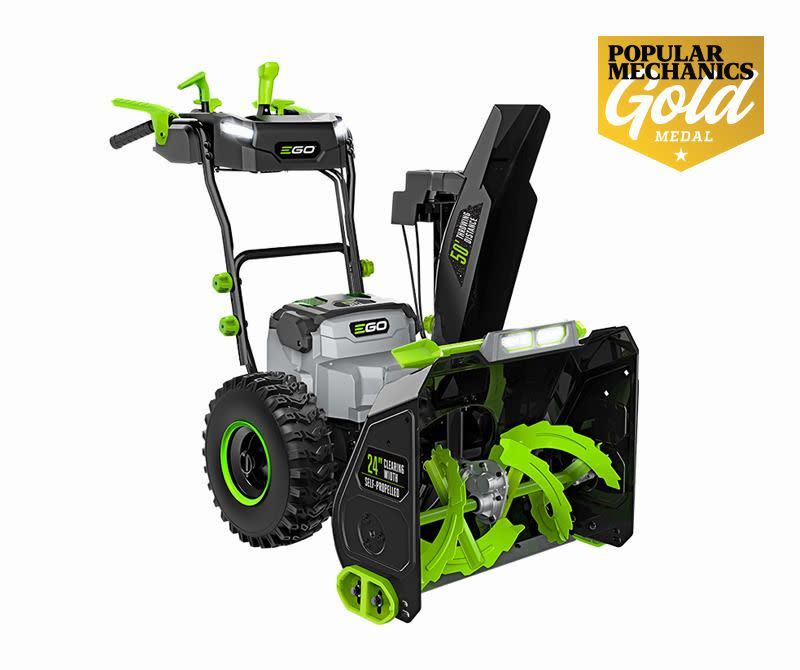
Power+ 2-Stage 24-In. Snowblower
$1499.00
lowes.com
We got one of the very first production models of Ego’s cordless, 24-inch, two-stage snowblowers. The steel-framed Power+ is very much like gas-powered units of its size, except for the electric motor and two 56-volt, 7.5-Ah batteries. Those two things give the Power+ some distinct advantages in the noise and weight departments, being both quieter and lighter than its fuel-sucking counterparts. Using it won’t hurt your hearing or wake the neighbors, and you won’t be laboring to move it around in the garage to store.
Ego claims a run time long enough to clear an 18-car driveway—that’s an area about 130 by 12 feet—of 8 inches of snow. This may be true with light, dry powder, but keep in mind the heavier and wetter the snow, the shorter the run time. Clearing our test area of sawdust—significantly heavier than all but the wettest snow—used up between 25 and 30 percent of the battery. It’s important to note we operated the auger in turbo mode to throw the sawdust as far as possible, a distance of 31 feet, but it does have a variable speed control. So you can adjust the auger as needed for the conditions and to preserve battery.
Using the Power+ is a breeze. With a differential in the axle and its relatively light weight, we found it very easy to maneuver. We like how freely the discharge chute moves through its 200-degree arc. But with a separate control for the deflector, it’s not as quick to adjust on the fly. Other features include four LEDs, adjustable plastic skid shoes that won’t mar garage floor coatings or walkway pavers, and adjustable handle height. The Power+ is one of very few cordless snowblowers with two stages, and overall, we were impressed with its capabilities. It threw wet sawdust well, which means it will have no problems in real snow.
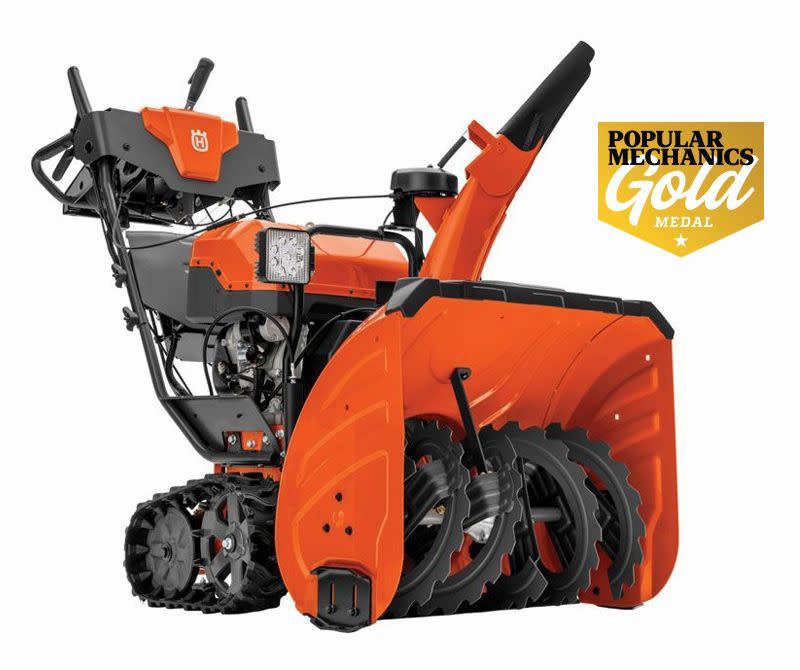
ST 427T Snowblower
$2999.99
acmetools.com
The burly 27-inch Husqvarna ST 427T is a professional-grade machine, capable of extended and frequent use. A hydrostatic transmission drives a pair of tracks and offers a wide range of speed, as well as plenty of traction and stability. The snowblower has an electric start, with a battery on board eliminating the need to plug into an outlet. And since it has electronic fuel injection, there’s no choke to set. Just turn the key and it will start and automatically adjust the fuel mixture for a wide temperature range and higher elevations.
Clearing our test area took 3 minutes 41 seconds, and it could have gone a little quicker—we got faster as we became more familiar with the hydrostatic controls. Once we had some time to get comfortable, it was easy to operate with one hand on the handle and the other controlling speed, the discharge chute, and the deflector. In our snow bank test, we threw the wet sawdust a remarkable 40 feet, and the ST 427T should throw snow even farther.
Two triggers, one beneath each handle, disengage the tracks on each side to control steering. The ST 427T has a lever on the console that allows the operator to bias the weight of the machine forward, to dig into packed snow, or back, lifting the front off the ground for better maneuverability when not blowing snow. And for those really dark, cold mornings, the ST 427T comes equipped with lights and heated hand grips.
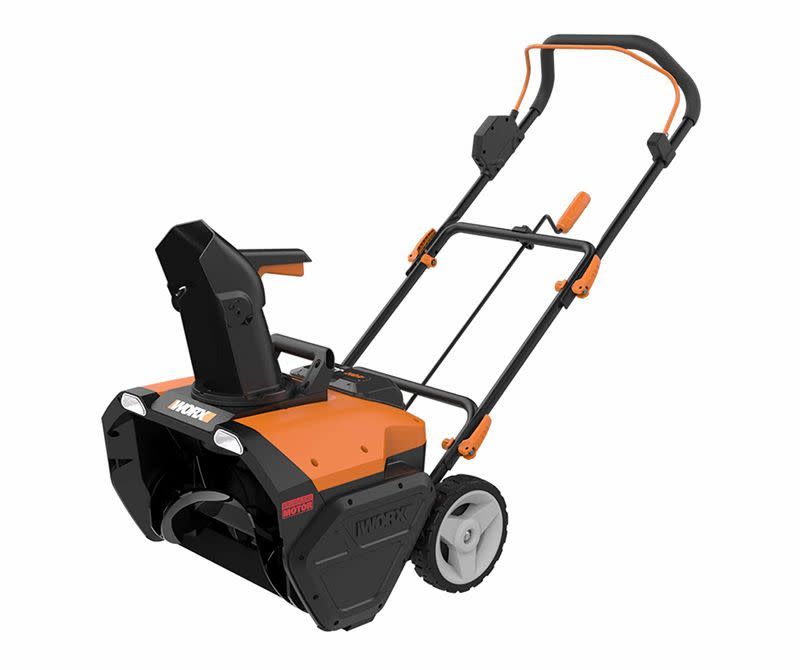
Power Share 20-In. 40-Volt Snowblower
$331.56
amazon.com
This 20-inch, 40-volt model from Worx is among the smallest snowblowers we’ve tested. Its size and folding handle make it ideal for homes without a lot of storage—and since it’s cordless, you can even store it in the bottom of a closet. The unit comes equipped with LED lights, in case you have to be up before the sun to dig out. If you do, it’s quiet battery power means you won’t wake anyone up doing so.
The Power Share has an intake depth of 10 inches and a width of 20, but it will be rare you’ll be able to take full advantage of both. Our testing was a little hard on this single-stage machine—the heavy, dense, wet sawdust was difficult to process. On a couple of occasions, pushing too hard stalled the paddle auger. We quickly learned how much load we could handle without it coming to a stop. With it, we were able to clear our test area in just under 7.5 minutes, which is on par with similar models we’ve tested. And it’s still better than shoveling.
In light, drier, snow conditions, we expect much better performance from the Worx machine. Real snow is much more slippery than wet sawdust and will move through the machine more easily. Nevertheless, we were able to match the claimed throwing distance of 20 feet with the remotely operated chute during our testing with the sawdust.
The 4-Ah batteries should last long enough (about 30 minutes) to clear a sidewalk or short driveway of 3- to 6-inch-deep snow. So a good snow-clearing strategy would be to go out when it hits 3 or 4 inches and clear it quickly, then repeat as necessary. Just remember, wetter, denser snow will run down the battery quicker.
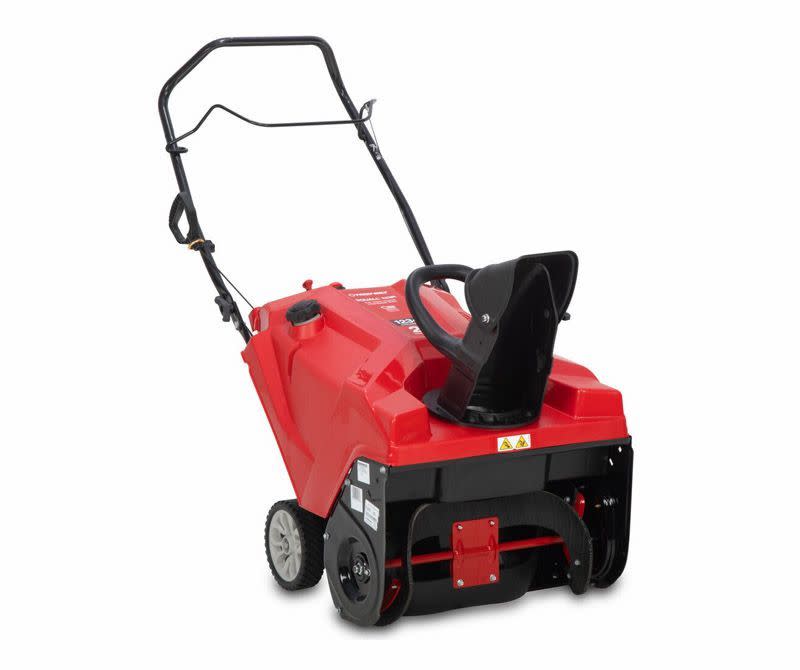
Squall 21-in. 123R
$499.00
homedepot.com
https://www.troybilt.comThe single-stage Troy-Bilt Squall 123R comes equipped with a rubber paddle auger that contacts the ground to help pull the machine, forward into the snow. The ejected snow is directed using a manual handle to control the chute, which we had to stop in order to adjust. Using the Squall, it took us 4 minutes and 31 seconds to clear our 6’ x 8’ x 5.5” test area, throwing the wet sawdust well clear of the space. We were able to clear nearly all the wet saw dust from the pavement, due to the paddle’s direct contact with the pavement.
The Squall is reasonably small, easy to maneuver, and can be used to clear a lot of snow. It’s a good choice for people who don’t want a bulky machine but need to clear a moderate sized driveway without too much slope. It started easily for us with the easy to reach, standard recoil-style starter.
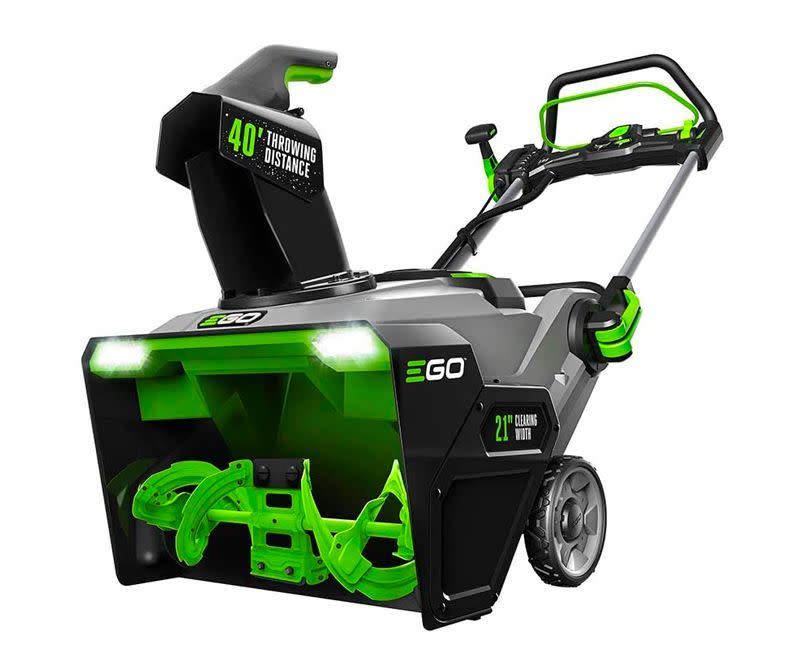
Power+ 21-In. Snowblower
$699.00
amazon.com
Ego claims its 21-inch Power+ snow blower can throw snow up to 40 feet with a 180-degree, adjustable chute, which is pretty far for a cordless machine. In the wet sawdust test, we were able to throw 24 feet with the heavier dense material—longer distances are certainly achievable with lighter, drier snow. It took the Power+ 4 minutes 16 seconds to clear the sawdust down to pavement in our area test. Like most single-stage blowers, the Power+ is not self-propelled, so we needed to push it into the snow. In our dense, heavy sawdust, that required some effort in order to make forward progress. It’s not a bad thing though, as it makes it easier to prevent the machine from digging in too deep and bogging down. In very wet or ice-packed snow, we expect you’ll have to put in a similar effort.
The Power+ has a variable speed auger, so we were able to adjust speed for the conditions and conserve battery when less power was needed. There isn’t too much to worry about in the battery department, since it comes with two 5-Ah batteries, enough to clear 8 inches of snow on a 12-car driveway—that’s six-cars long by two-cars wide. The Power+ comes with a dual-port charger, so the two batteries can be charged simultaneously to get you ready for the next round faster. Ego rounds things out with front-mounted LEDs for low-light and dark conditions, plus an easy folding handle for stowing the unit when not in use.
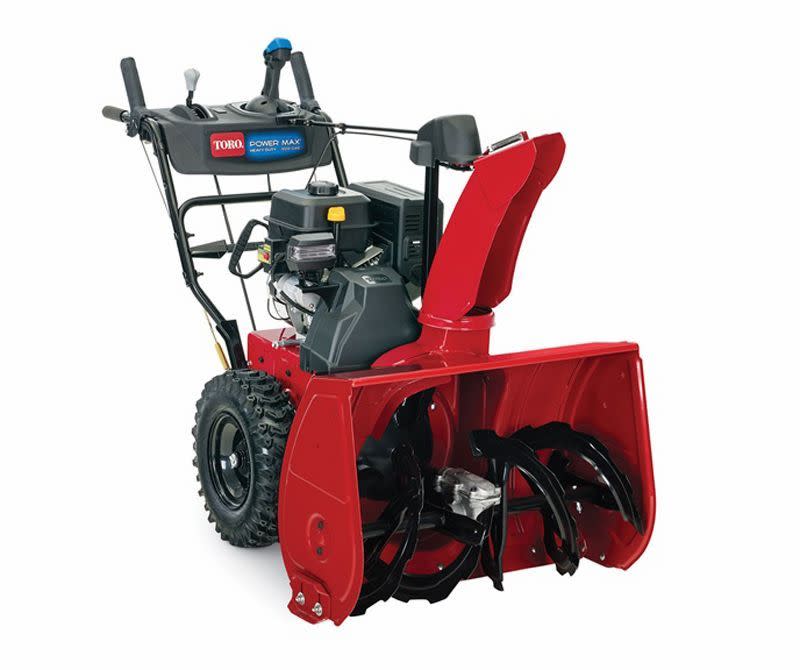
Power Max HD 828 Snowblower
$1599.00
homedepot.com
At 28 inches wide, Toro’s Power Max HD 828 is big enough to tackle large areas but small enough to maneuver on most walkways. HD (for “heavy duty”) means that the 828 features steel construction of all the major parts, including the intake housing, discharge chute and deflector, impeller housing, and frame. In fact, the only significant plastic parts we found were the belt cover and control panel cover.
We really like Toro’s “Quick Stick”—the combined chute and deflector control—which takes very little effort to reposition on the fly. In the snow bank portion of our test, we were able to direct and throw the sawdust 34 feet, sweeping either left or right—a bit less than the claimed 45 feet, but wet sawdust isn’t as slippery as snow and doesn’t throw as far. In our area test, we were able to clear the sawdust quickly and efficiently, in 2 minutes 46 seconds.
The recoil starter on the Power Max HD 828, which we used most of the time, didn’t require a lot of effort to pull, starting in just one yank with the choke on when cold. The electric start, powered by an extension cord, is handy for exceptionally cold days, when thicker oil makes it harder to pull the recoil starter. Other features include adjustable skid shoes, a differential axle for easy turning, and a single LED headlight. Own a home with a medium to large driveway? This one’s for you if you’re okay with the price.
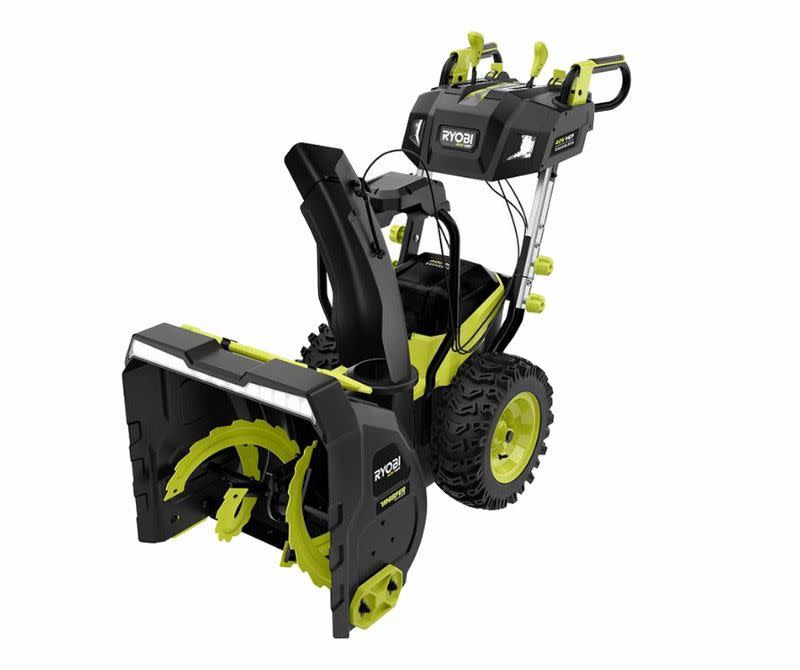
40V Whisper Series 24-in. Snowblower
$1799.00
homedepot.com
CourtesyRyobi’s 40V Whisper Series Two-Stage arrived after our testing was complete, in the middle of the winter. So, while we didn’t run it through our sawdust testing, we were able to use it during two northeast snowstorms. Remarkably, we found it operates and performs much like a similar-size gas-powered snowblower—of course, without the noise. This Ryobi felt sturdy, substantial, and familiar, testament here too to how it’s built very much like a gas-powered machine.
The 40V Whisper Series comes with four batteries that you use in pairs. So while the battery bay holds all four, we found you only need two in the machine at any time in order to use it. We started with all four at full charge, and when the first two ran down, we swapped them out to the dual charger while we continued working. However, we were able to clear our driveway (approximately six cars long by two cars wide) during each storm without needing more than four full batteries.
In the right conditions, when the snow wasn’t too wet, we were able to match the claimed throwing distance of 55 feet. While the blower has variable auger speed, we generally ran it at full speed except in the driest, lightest snow—once it started to get wet and heavier, it was most effective to run it full on. Like many gas models, it has a live axle with both wheels locked together turning at the same speed, so we had to muscle it a little to get it to turn—this was made a little easier due to a lower weight of the electric machine.
Overall, we found the 40V Whisper Series Two-Stage to be a very competent machine, easily capable of replacing a gas-powered snowblower of the same size.
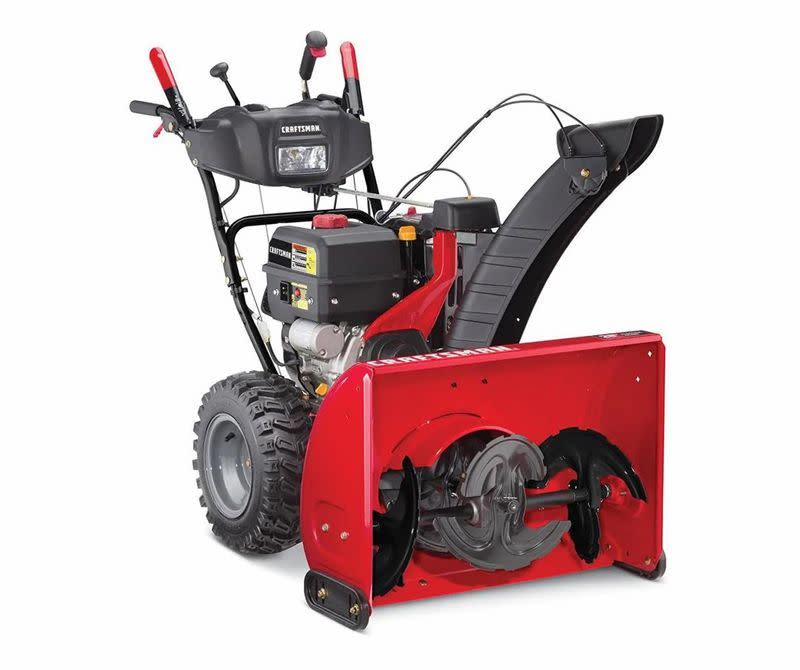
SB650 Snowblower
$1699.00
lowes.com
CourtesyThe Craftsman SB650 has one more “stage” than most other snowblowers its size. Normally, the auger pushes snow to the center, which is swept toward the intake housing and the impeller by the snow behind it. The SB650’s third stage is a front-facing auger in the center and acts like a screw, pulling snow back into the impeller faster. This is an advantage when clearing dense snow left by plows at the end of the driveway or heavy, wind-driven snow drifts. The third stage digs its way into the dense snow, rather than just scraping the edge of it.
In testing, the SB650 feels much like any other snowblower. Power steering facilitates quick turns—pull a trigger below either hand grip to head in that direction. One advantage with this type of system is that the axle is normally locked, which made it easy for us to keep nice, straight lines. It took us 3 minutes 9 seconds to clear the 8 by 6-foot area. But during the snowbank test, we got to see just how the third stage worked as it consumed the dense pile of wet sawdust. The material gets to the impeller faster and at a steadier rate. We threw the sawdust up to 27 feet, although snow will go significantly farther.
The SB650 comes with long, poly skid shoes, which slide easily on pavement and won’t mar or scuff walkway pavers or fancy garage floor coatings. Other features include push-button electric start, a headlight on the control panel, and a single-hand discharge chute and deflector control. Craftsman’s SB650 is a good option for people with large areas to clear, as well as those whose property typically sees dense, packed snowbanks.
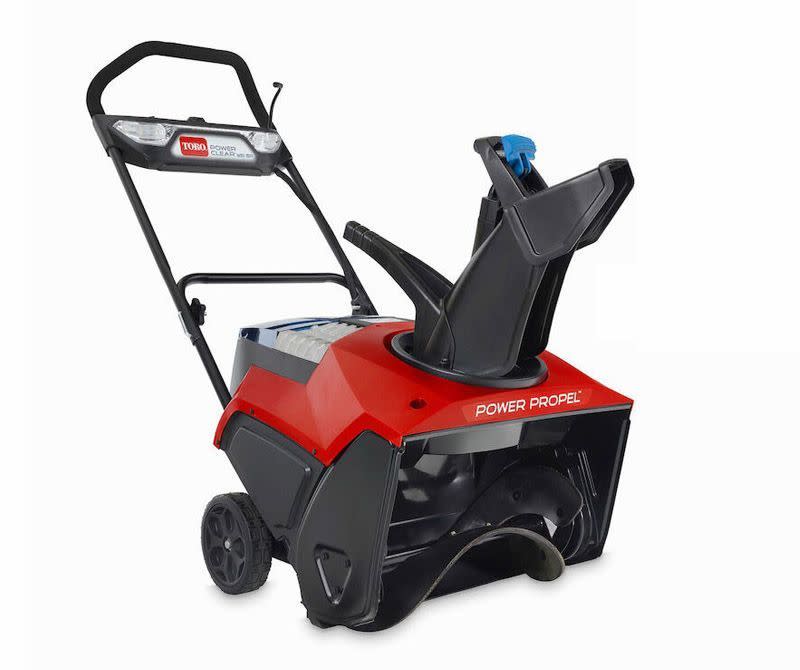
60V Max 21” Power Clear
$899.00
homedepot.com
https://flexforce.toro.comToro’s 60V Max 21” Power Clear single-stage snowblower is an example of how good cordless machines have become. It’s among the fastest single-stage units—it cleared our test area in 4 minutes flat. As with other blowers this size, we needed patience to avoid digging in too deep and slowing the auger. We quickly figured out the right pace to clear the heavy sawdust and were able to make steady progress. The manual discharge chute worked in the same fashion as other single-stage models and functioned effectively in our testing.
The 60V Max comes with two batteries, so when one gets low you can start charging the other. One advantage with cordless models is the noise, or rather the lack of it. You’ll never need to worry about bothering the neighbors if you need to start early in the morning or finish late at night. The other benefit we enjoy is that we don’t need to deal with hearing protection—or ringing ears when we’re done. When not in use, the handle folds down so the 60V Max takes up minimal space in your garage.
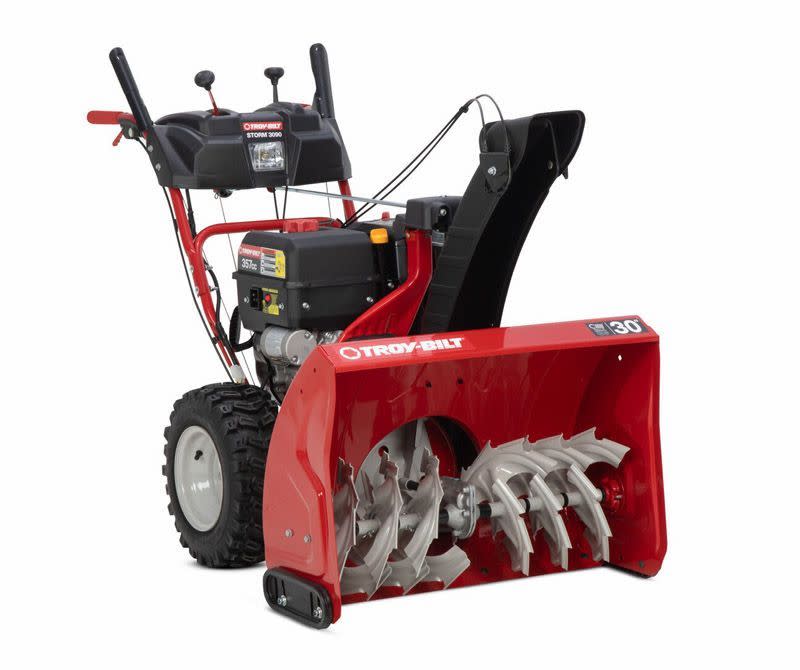
Storm 3090
$1599.00
homedepot.com
https://www.troybilt.comThe Storm 3090 is designed for folks with a lot of ground to cover—or uncover, as the case may be. The wide intake housing and auger are capable of clearing a 30-inch path in one pass. Pushing it around the garage, we found it surprisingly agile, able to make sharp, quick turns thanks to its Touch ’n Turn steering triggers. Under power, we could easily turn the Storm 180 degrees for a return pass, simply by pulling the trigger on the side of the direction we wanted to turn. Despite its nimble nature, at 30-inches wide, it may be too big for narrow walkways or awkward in tight spaces.
It took us just under 4 minutes to clear our test area of the wet sawdust, which moved through the machine somewhat slower than actual snow would have. With a 20-inch tall intake housing, the Storm will be capable of cutting through deep drifts or plowed-in piles of snow at the end of your driveway. The discharge chute rotates manually via a hand-crank. And, although it was warm during our testing, we flipped on the heated hand-grips to be sure they functioned properly. From experience, we know that warm hands always make for a more pleasant time working in the snow when the temperature drops.
You Might Also Like


